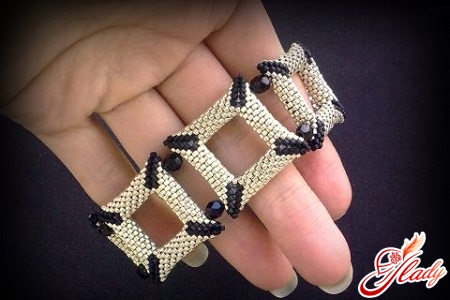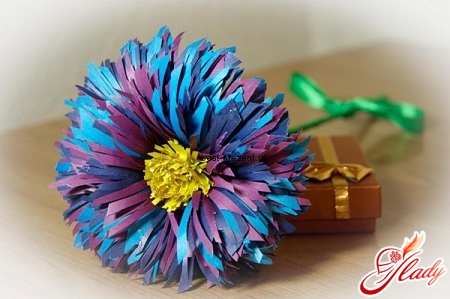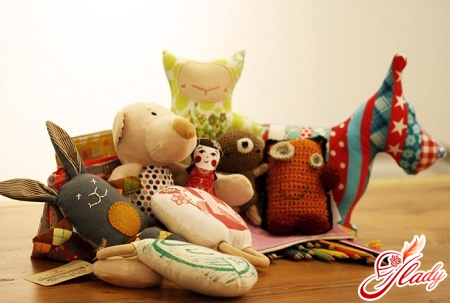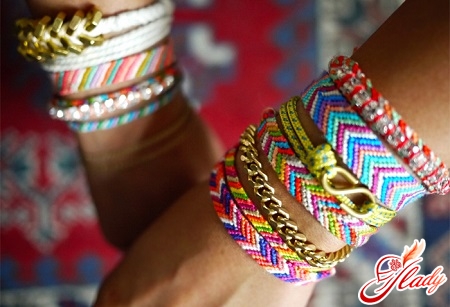
Baubles are often called bracelets of friendship. It is believed that they bring good luck. In addition, it is an original and stylish accessory. The easiest way to braid the baubles is from thread to mulina. You can buy them in shops for needlework, the brighter the threads, the more beautiful the product will be. Color bracelets will be a unique decoration, help stand out from the crowd, and will also be a good gift for friends. How to weave bra from a floss? To learn this is not difficult, you just have to be patient. For work you will need:
- Threads of a mulina of different colors.
- Scissors.
- Needle.
- Pin is English.
- Pillow is small in size to pin up the product during operation.
In order to calculate the length of the filaments,measure the volume of the wrist and multiply this value by 4, adding 5-10 cm to make the bracelet ties. The ends of the threads are fixed with a pin, then when weaving, the baubles will not twist. Before we begin to weave a bra from a floss, one must learn how to perform 4 basic knots. 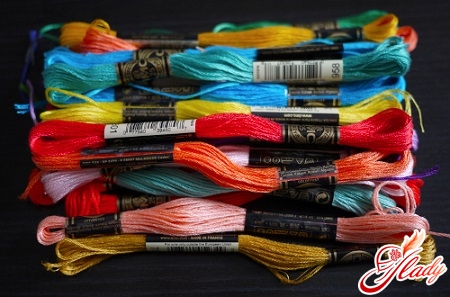
Types of units and techniques for their execution
- In the technique of weaving, there are always 2 threads: working (with its help knots are made) and axial, on which knots are knit. In the process of weaving, they constantly change places, i.e. Work becomes axial and vice versa.
- The general principle of knotting is as follows: the axial thread is taken in one hand and tightened, and the other hand with a working thread becomes a bundle. It is necessary to take an even number of threads of a floss (not less than 4). They gather in a bundle and are tied with a common common knot. In this case, the distance from the knot to the edge should be 5-10 cm, to then weave the pigtail, which will be a string for the finished bracelet. Mulinoe fastened with a pin to the pillow or with the help of an adhesive tape to the table.
- The right hinge node. In the hand takes the leftmost thread and stretches, it will be axial. With the right hand, the working thread, in this case following the axial thread, wraps around it from left to right. Then, through the formed loop, it is necessary to pull the tip of the thread and move the knot up. In the same way, make a second nodule and push it close to the previous one. Now the working and axial threads changed places and, accordingly, changed the working functions. If a knot accidentally turned out to be too tight, you can stretch it using a needle.
- Left hinged knot. It is executed as a mirror image of the right node, i.e. The threads of the mule are taken from the right side and the knot on the axial thread is knitted from right to left.
- Right turn. On the axial thread, the right knot is first done, and then the left knot is done.
- Left turn. First, the working thread is the left loop, then the right one.
Thus, from the set of nodules tied upin different ways in a certain sequence, the pattern is weaved. There are a lot of variants of weaving. First, it is necessary to master the simplest and most accessible to understand the scheme of weaving the baubles from the mulina. Subsequently, you can master and more sophisticated techniques for making bracelets and other fashionable jewelry, knowing how to weave the baubles of thread. 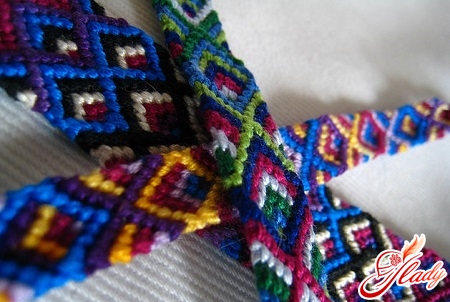
Ways of weaving the baubles
The simplest weaving used inis a pigtail. It is woven with 3 threads. If the number is more, then they are all divided into 3 parts and the usual plait is plied. So often the ends of a floss are braided when finishing work on the product. But there are schemes of weaving of 4 and 5 elements, then we get more interesting and beautiful bracelets.
- To weave a braid of 4 threads (as well as any even number), you have to take 2 central threads each time and move the left one to the rightmost row, and the right one to the left and so on to the end.
- For braids of 5 threads and another oddthere is a scheme, which is called the cord of an aglet. Weave in this case, moving the left thread first to the center, and then the right one. And so repeat the required number of times. There are other schemes of weaving braids, more complex.
Manufacturing of baubles with oblique weaving It is necessary to take,for example, 6 threads of a floss of the desired length. Let them be in 3 colors, 2 in each color. After the mulina will be knotted and fastened with a pin, you can go directly to the oblique weave. To do this, the threads are sorted by colors, then the first on the left are 2 nodules on the second. In the same way knots knit the first thread on the third, fourth, etc. It is necessary to try to place each subsequent knot slightly below the previous one. After the end of the first row, again the first thread is taken from the left and the second row is padded. And so, from left to right, we row along the row. After reaching the desired length of the bracelet, at both ends braids are braided approximately 2 cm, which ends with nodules. In order to fasten a fresco on your hand, you can make a loop at one end and tie a bead on the other, which acts as a button. But this kind of fastening is not very reliable and the bauble can accidentally unfasten. It is best to buy in the needlework store locks of the right color and design. Straight weaving can create more complex patterns. Leading here will be the extreme left thread, which must be done longer than the others. Twisting each thread one after the other, it is necessary to finish the first row, then the same row is followed by the second row from right to left, then the third from left to right. So you have to weave to the desired length of the bracelet. If it is necessary to begin weaving the pattern, then the leading thread is braided axially. The nodule then changes color and you need to do it in the opposite direction, then you can continue to weave the leading thread. Weaving according to schemes Having figured out how to weave bracelets from threads according to schemes, you can learn how to make very beautiful and original bracelets. At first it is better to use ready-made schemes, then you can compose them yourself.
- Usually the diagrams indicate the colors thatare used for weaving. But it is not necessary to take precisely these combinations, the main thing. so that the color varies quantitatively. Threads are distributed according to colors according to the scheme, tied with a large knot and fastened with a pin. If the diagram contains a picture, then the background thread should not be cut off and go from the tangle.
- As a rule, all schemes denote nodes andarrow shows how to guide the threads when knitting knots. The diagonal arrow pointing down to the left means that you need to wrap the right thread on the left thread and drag the end to the loop, then return it to its original position and make another similar node.
- The downward arrow from the left to the right indicates a node that fades like the previous one, but with the help of the left thread.
- A broken arrow pointing to the left shows that you should tie two nodules in opposite directions: the first with the left thread, the second with the right one.
- The curved arrow to the right means 2 opposite nodes, of which the first is the right one, and the second is the left one.
- When weaving a burglary from a floss with a pattern, we mustfix the thread of the contour and knit the nodules of the background color on it. If you want to add a third color, the new thread is tied to the main one and the required number of knots is sewn. The main thread is located behind the product and, if necessary, is added to the work.
According to the schemes, braided banners with variousdrawings, with names, with sharp corners. Very fashionable is a pattern in the form of checkers. Very interesting looks pattern from diamonds of different colors. To diversify the bracelets and give them originality, you can make baubles with rhinestones, chains. There are schemes in which beads, beads and metal elements are interwoven.




